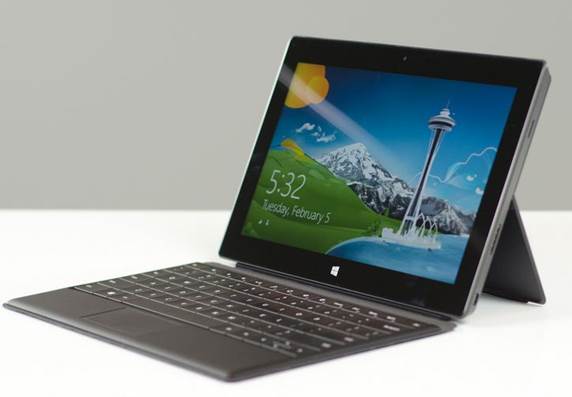Windows 8
tablet
Microsoft's Surface Pro, launched in New
Zealand at the end of May, joins the company's Surface RT on shelves as its
flagship Windows 8 tablet.
Whereas the Surface RT is based on an ARM processor
and will only run 'Modern' Windows 8 store apps, the Pro is built on the same
Intel Core i5-3317U CPU found in many Ultrabooks and laptops. It runs the full
version of Windows 8 Pro, and can run any application that would work on a
similarly- specked Windows 8 laptop or desktop PC.
We've tested a wide range of Windows 8
tablets lately, all running the full version of Windows 8 and thus able to run
'legacy' desktop applications. However, all but one (Acer's Iconia Tab W700)
were based on the Intel Atom Z2760 CPU, which offers brilliant battery life but
severely limits the device's ability to run computationally or graphically-
intensive applications (forget working in Photoshop or transcoding video in
anything neat real-time, for example).

Microsoft's
Surface Pro, launched in New Zealand at the end of May, joins the company's
Surface RT on shelves as its flagship Windows 8 tablet.
The Surface Pro really does offer laptop-
equivalent performance, in line with a similarly priced Ultrabook. However, that
comes at the cost of a thicker build, greater weight, and shorter battery life
than those Atom-based Windows 8 tablets - some of which are thin and light
enough to compete with Apple's iPad and Samsung's GalaxyTab.
The Surface Pro is 13mm thick, and weighs
910 grams. It's cased in magnesium-alloy for resilience, and includes a
fixed-angle kickstand at the rear which works best in landscape mode (it will
hold the tablet up in portrait, but not all that stably and only at a
near-vertical angle).
Microsoft has used a novel venting method,
with a narrow grille along the entire top edge and halfway along each side,
allowing the airflow necessary to keep the Core i5 CPU running. The Surface
does get warm during normal use, notably so when it's working away at some
CPU-intensive task, but never too hot to handle.

The
Surface Pro is 13mm thick, and weighs 910 grams.
Battery life is very limited - our
'Productivity' run-down test gave us just 2 hours 48 minutes, less than 60% the
battery life offered by Acer's Iconia Tab W700, and less than 40% the average
battery life of Atom-powered Windows tablets we've tested recently. With more
conservative use - web browsing and document editing, we averaged a very
laptop-like 4-5 hours.
The 10.6-inch screen sports an ample 1920 X
1080-pixel resolution, at around 208 pixels- per-inch. That's not quite as
sharp as Apple's iPad with Retina Display (264ppi), but we didn't find it
lacking. The display supports 10-point multi-touch, and a pressure-sensitive
digitizer pen is included with purchase. Not only great for drawing, the pen is
useful for operating Windows desktop applications that weren't designed with
touch in mind.
Connections include mini DisplayPort, a
single USB 3.0 port, headphone socket, microSD card slot, and magnetic
connectors for the proprietary charger and optional Touch or Type keyboard
covers.

The
10.6-inch screen sports an ample 1920 X 1080-pixel resolution, at around 208
pixels- per-inch.
The Touch Cover is almost as thin as
Apple's iPad Smart Cover, but includes a touch-based QWERTY keyboard. Its
immobile keys and limited response speed make it unsuitable for touch-typists,
but it's still much faster than typing on-screen for those of the hunt-and-peck
persuasion. The Type Cover is marginally thicker, but offers a fully functional
QWERTY dome keyboard, with reasonable key travel and excellent response for
high-speed typists.
Both covers include a dinky, barely-usable
track-pad for cursor control - fortunately not all that necessary given both
the touchscreen and pen.
Honestly, those two keyboard covers are
true marvels of engineering. Were they available for Apple's iPad, they'd
surely give Logitech and Belk in a run for their money.

However
good the keyboard covers, its lack of an integrated keyboard conspires with its
very limited wired connectivity to bring it just short of 'laptop' status.
The Surface itself, on the other hand,
ultimately failed to impress us. It looks good, it's solidly constructed and
functions well enough, but it just doesn't seem to fit anywhere. However good
the keyboard covers, its lack of an integrated keyboard conspires with its very
limited wired connectivity to bring it just short of 'laptop' status. Its
weight, thickness and - for a tablet — atrocious battery life bring it crashing
down well short of that category, too. The Surface aims to bring users the best
of both worlds, and struggles to deliver either.
It's not a complete failure-those
desperately seeking a laptop-powered, tablet-sized device won't find a much
better option, whatever its limitations. However, we wouldn't recommend you
rush out and buy one to replace your perfectly functional Ultrabook and iPad.
|
At a glance
·
10.6-Inch 1920 x 1080-pixel display
·
Intel Core i5-3317U dual-core 1.7-2.5GHz CPU
·
4GB RAM, 128GB SSD storage
·
Windows 8 (64-bit)
·
275 X173 X 13mm, 910g
Microsoft surface pro (128gb)
·
RRP incl GST: $1,399 {64GB), $1,499 (128GB)
·
Contact: microsoft.co.nz
·
Rating: 3/5
·
Some neat Innovation, and the most technically
capable Windows 8 tablet we've tested, but ultimately fails to rock the boat
or carve out enough of a niche to survive in.
|